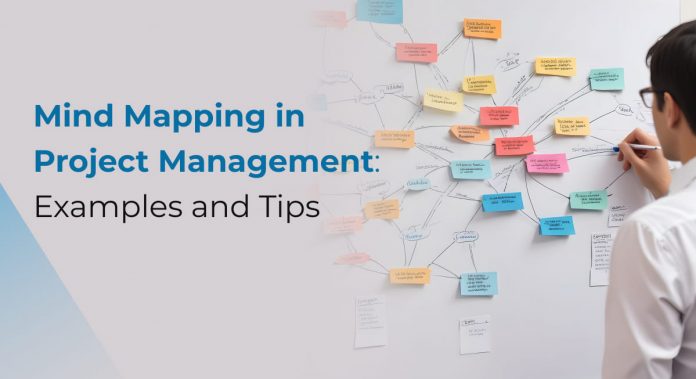
Mind mapping is not just a tool but a revolutionary approach that enhances clarity, communication, and creativity in project management. By visually structuring thoughts and ideas, mind maps help break down large projects into manageable components, making it easier to assign tasks, track progress, and achieve project objectives.
We’ll guide you through the fundamentals of mind mapping in project management, provide practical examples of how it can be applied in different stages of project management, and share expert tips to maximize its effectiveness.
Whether you’re dealing with project timelines, resource allocation, or risk assessment, mind mapping can offer a fresh perspective and a competitive edge.
Table of Contents:
- What is a Mind Map?
- History of Mind Map
- Rules of Mind Mapping
- How to Utilize Mind Mapping for Project Management?
- Benefits of Mind Mapping in Project Management
- Applications of Mind Mapping
- Popular Mind Mapping Softwares
- Conclusion
What is a Mind Map?
Mind mapping is a visual technique that organizes and represents information, ideas, and concepts in a hierarchical or interconnected structure. Typically, it starts with a central concept or theme, which branches out into subtopics or related ideas, forming a tree-like diagram.
These branches can further extend into more detailed subtopics, creating a comprehensive and visually engaging representation of the subject matter.
Mind maps can incorporate keywords, images, colors, and symbols to enhance understanding and memory retention. They serve as powerful tools for brainstorming, planning, problem-solving, note-taking, and organizing complex information to stimulate creativity and promote clear thinking.
History of Mind Map
The history of mind mapping can be traced back to the notes of famous thinkers throughout history, such as Leonardo da Vinci, Charles Darwin, Thomas Edison, and Albert Einstein. These geniuses used visual representation, keywords, and diagrams in their notes, rather than traditional sentences, to organize their thoughts and ideas.
In the 20th century, British psychologist Tony Buzan popularized the concept of mind mapping. Buzan experimented with different note-taking methods and found that traditional linear notes were ineffective for learning.
He developed the concept of mind mapping by underlining keywords, boxing ideas, adding color, and drawing lines between associated words. Buzan discovered that only 10% of his linear notes contained important key ideas, leading him to develop a more efficient and effective way to take notes and enhance memory.
Buzan further researched note-taking and learning techniques, finding commonalities among the notes of other great thinkers throughout history. He observed that these individuals did not use sentences and linear styles in their notes but instead used visual elements like doodles, pictures, and diagrams, similar to his own mind-mapping method.
This led Buzan to conclude that visual note-taking methods, like mind mapping, are more effective for organizing thoughts, enhancing memory, and stimulating creativity.
Rules of Mind Mapping
To effectively utilize mind mapping in project management, it’s crucial to understand and follow certain rules. These rules help ensure your mind maps are clear, organized, and conducive to creative thinking.
- Start with a Central Idea: Begin your mind map with a central topic or theme placed in the center of the page. This focal point will serve as the starting point for all other ideas, providing structure and direction to your map
- Use Radiant Thinking: Radiant thinking encourages ideas to flow outward non-linearly. This simulates the natural way our brains make connections, fostering creativity and allowing for diverse associations between concepts
- Utilize Keywords and Images: Use concise keywords, phrases, and brief statements to represent ideas on your mind map. Incorporating visual elements like images, symbols, and colors enhances understanding and helps memory retention, making your mind map more engaging and effective
- Connect Ideas with Branches: Create branches to connect related ideas to the central topic. Each branch represents a different aspect or subtopic, forming a hierarchical structure that organizes information logically and helps to visualize relationships between concepts
- Embrace Associations: Link related branches to encourage the exploration of associations and connections between ideas. This promotes a deeper understanding of relationships and patterns within the information, fostering insight and creativity
- Maintain Balance and Harmony: Ensure that your mind map maintains balance and harmony by distributing content evenly across the page and utilizing whitespace effectively. This promotes clarity and readability, making it easier to absorb information at a glance and facilitating effective communication of ideas
- Allow for Flexibility and Creativity: Embrace flexibility and creativity in your mind-mapping process. There are no strict rules, so feel free to experiment with different layouts, colors, and styles to suit your preferences and needs. This encourages innovation and personalization, allowing you to create mind maps that reflect your unique thought processes and perspectives
How to Utilize Mind Mapping for Project Management?
In this section understand the strategic application of mind mapping in project management. Also, get an overview of the practicalities, offering insights, examples, and expert tips to optimize your project planning and execution. Control the visual clarity of mind maps to enhance collaboration and easily streamline complex projects.
Clarify Project Scope
Mind mapping helps in clearly defining the boundaries and objectives of a project. By visualizing project scope, including deliverables, timelines, and constraints, ensures that everyone involved has a better understanding of what needs to be achieved.
Strategize and Plan
Mind maps offer a structured approach to project planning. They break down the project into smaller, actionable tasks and arrange them hierarchically to create a roadmap for implementation. This helps identify potential bottlenecks, allocate resources efficiently, and ensure smooth execution.
Encourage Collaboration
Mind maps serve as collaborative platforms where team members can contribute ideas, suggestions, and real-time feedback. By facilitating open communication and sharing diverse perspectives, mind mapping encourages innovation, fosters team collaboration, and increases buy-in for project goals and strategies.
Prioritize and Assign Tasks
Prioritization is crucial for effective project management. With mind maps, you can visually prioritize tasks based on priority, importance, and dependencies. Assign responsibilities to team members, set deadlines, and track progress to ensure alignment with project objectives and timelines.
Visualize and Present
Mind maps provide a visually compelling way to present project plans, progress updates, and key insights to stakeholders. Whether in meetings, reports, or presentations, visual representations enhance comprehension and engagement, making it easier for stakeholders to grasp complex information and make informed decisions.
Record and Retain Information
Mind maps are an effective storage element for project-related information. Capture meeting notes, decisions, and action items directly on the mind map to keep everyone on the same page. As a living document, the mind map can be updated in real time, ensuring that the latest information is always accessible and retained for future reference.
Benefits of Mind Mapping in Project Management
Mind mapping offers a range of benefits to project managers and teams, enhancing project planning and execution. Understanding these benefits can help you grasp the knowledge of mind mapping to improve collaboration, creativity, and overall project success.
Enhanced Memory Retention
Mind maps help you remember project details better because they organize information visually. When you see things arranged in colors and shapes, your brain can remember them more easily. Also, making the mind map can make you remember things better because you’re actively working with the information. This means you’re not just reading or listening but doing something with the information, which helps it stick in your mind.
Structured Problem Solving
Mind maps break down big project problems into smaller, easier parts, making it less overwhelming and easier to figure out what to do. It’s like taking a big puzzle and breaking it into smaller pieces. Then, you can focus on solving one piece at a time instead of tackling the whole puzzle all at once. This helps project managers stay organized and focused, which leads to better solutions and fewer mistakes.
Stimulated Creativity
Mind maps let you be more creative when planning projects. They’re like a playground for your ideas because you can combine them in different ways. This creativity helps develop new and better ways to solve problems and make projects successful.
By visually organizing your thoughts and ideas, mind maps encourage you to think outside the box and explore different possibilities. This can lead to innovative solutions and fresh perspectives that might not have been considered otherwise.
Efficient Planning and Analysis
Mind maps help you plan projects better by organizing all the important stuff visually. They make it clear what needs to happen first, what comes next, and what’s most important. This makes it easier to make decisions and use resources wisely.
Instead of having scattered notes and lists, everything is laid out in a logical and easy-to-understand format. This makes it easier to see the big picture and identify any potential problems or roadblocks before they become major issues.
Clear Task Management
Mind maps make it easy to see who’s doing what and when it needs to be done. They help everyone know their responsibilities and keep track of progress. This way, things get done on time, and everyone knows what’s happening.
Instead of depending on email chains or meetings to communicate tasks and deadlines, everything is clearly outlined in the mind map. This makes it easy for team members to stay organized and focused on their work, increasing productivity and efficiency.
Streamlined Meeting Organization
Mind maps make meetings easier to plan and run smoothly. They help keep everyone focused and ensure important topics are discussed. With a mind map, it’s easier to remember what was decided and who needs to do what after the meeting.
This helps prevent misunderstandings and ensures that everyone is on the same page. Additionally, because everything is laid out visually, it’s easier for everyone to see how different ideas and topics are connected, which can lead to more productive discussions and better decision-making.
Applications of Mind Mapping
Mind mapping is a flexible tool used in education, business, and personal growth. It helps organize thoughts, generate ideas, and plan projects effectively. Its visual format boosts creativity, aids problem-solving, and improves decision-making in studying, strategizing, or innovating.
Here are a few applications of mind mapping:
Goal Setting and Tracking
Mind maps facilitate setting and tracking project goals, both short-term and long-term. Visualizing goals helps maintain focus and inspires action towards their achievement. A structured goal-setting method, such as S.M.A.R.T. goals, within a mind map framework, ensures clarity and motivation in a goal plan.
Meeting Planning and Organization
Planning and conducting project meetings can be streamlined with mind maps. They help organize meeting agendas, ensure important topics are covered, and keep discussions on track. The visual format enhances engagement and comprehension among team members, leading to more productive and focused meetings.
Information Management
Mind maps help manage information overload by providing a centralized platform for organizing project-related data, ideas, and notes. With keywords, images, and brief notes organized within a single page, project managers can quickly access and make connections between different pieces of information, fostering a clear understanding of project details and facilitating decision-making.
Presentation Preparation
Mind maps help in preparing project presentations by facilitating brainstorming, organizing ideas, and structuring content. They allow for quick sorting, editing, and adding of presentation elements, resulting in engaging and focused presentations.
With color and image usage, mind maps enhance audience participation and discussion during presentations, ensuring effective communication of project information.
Decision-making
Mind maps provide a structured approach to decision-making by allowing project managers to visualize and organize possible solutions to project-related issues. By starting with the main problem and developing a hierarchy of options, mind maps help explore different angles and identify unique solutions.
This systematic process streamlines decision-making and promotes confident and informed choices throughout the project lifecycle.
Popular Mind Mapping Softwares
When it comes to mind mapping in project management, various software options are available to assist in creating mind maps. These tools offer unique features and interfaces that cater to different project management needs.
Here are some of the popular choices:
- Coggle: Coggle is an online collaborative mind-mapping tool that allows users to create and share mind maps in real-time. With its simple and intuitive interface, Coggle enables users to easily organize ideas, brainstorm collaboratively, and visualize concepts.
- MindMeister: MindMeister is a web-based mind-mapping software that offers a range of features for brainstorming, planning, and organizing ideas. It allows users to create interactive mind maps, collaborate in real-time, and integrate with other productivity tools for seamless project management.
- Ayoa: Ayoa (formerly known as iMindMap) is a versatile mind mapping and task management tool designed to boost creativity and productivity. It offers a variety of visualization options, including radial maps and organic mind maps, along with task management features to help users turn ideas into actionable plans.
- FreeMind: FreeMind is an open-source mind-mapping software that provides a lightweight and flexible platform for creating structured diagrams. It offers basic features for organizing ideas and concepts, making it suitable for users looking for a simple mind-mapping tool.
- XMind: XMind is a popular mind-mapping and brainstorming tool that offers a range of features for creating and sharing mind maps. It provides various templates, styles, and customization options to suit different needs, making it a versatile choice for individuals and teams.
- Lucidchart: Lucidchart is a cloud-based diagramming software that offers mind-mapping capabilities along with other diagramming tools. It provides a user-friendly interface, collaboration features, and integration with other productivity tools, making it suitable for personal and professional use.
Conclusion
Mind mapping in project management serves as a powerful tool, enhancing organization, creativity, and communication from planning through execution. Embracing its rich history and modern digital applications can transform your project management processes.
It supports a systematic task approach, ensuring that big-picture goals and minute details are captured. Mind mapping encourages a collaborative environment where team members can see the interconnections between their tasks, fostering a better workflow and greater innovation.
For those looking to develop their project management skills further, consider the comprehensive Project Management Courses offered by Invensis Learning. Enhance your professional abilities and achieve project success by exploring our training options.
















